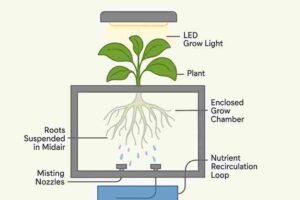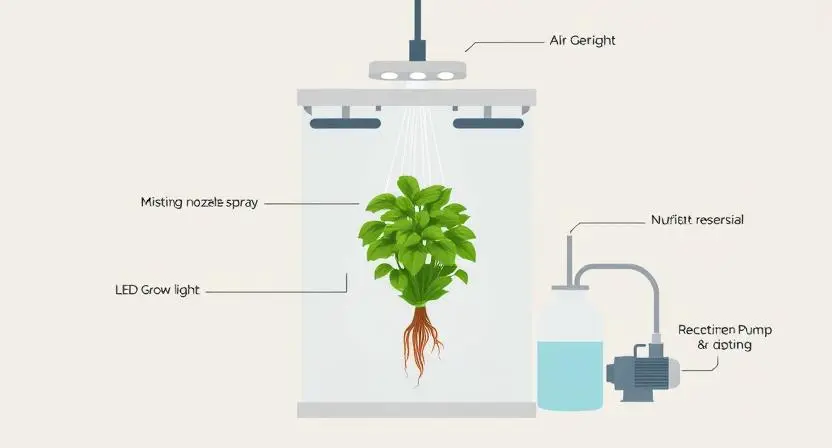Aeroponic Farming: Everything You Need to Know
Aeroponic farming grows plants without soil, using nutrient-rich mist to nourish roots suspended in air. This high-tech method is changing how we think about food production. By removing soil and reducing water use, aeroponics allows plants to grow faster and cleaner in controlled environments.
Why does it matter? Because traditional farming demands large areas of land, consistent weather, and plenty of water. Aeroponic systems flip that model. They can thrive in tight spaces—like basements, greenhouses, or urban rooftops. They’re also more sustainable, using up to 90% less water than soil farming.
This guide will explain how aeroponic farming works, its key advantages, the common challenges, and how you can start your own system. Whether you’re curious about the future of farming or considering a home setup, everything you need to know is here.
How Aeroponic Farming Works

Aeroponic farming works by suspending plant roots in the air and misting them with a nutrient-rich solution. There’s no soil and no growing medium. Instead, the roots hang in a closed environment where they receive a fine spray of water and nutrients at timed intervals.
The system runs on a closed-loop design, meaning unused nutrients are collected and recycled back into the system. This setup reduces waste and keeps nutrient delivery precise and efficient. Oxygen flows freely to the roots, which boosts growth and reduces disease risk.
Aeroponic farms are often built in controlled environments. You’ll see vertical towers, enclosed grow chambers, and stackable trays used in home and commercial systems. These setups allow full control over humidity, light, and temperature—making year-round farming possible.
Key Advantages of Aeroponic Farming
Aeroponic farming offers major benefits that make it a smart choice for future food production. It’s cleaner, faster, and more efficient than traditional soil-based methods.
One of the biggest advantages is water savings. Aeroponic systems use up to 90% less water than conventional farms. Because water is recycled in a closed-loop system, there’s almost no waste.
This method also reduces pests and diseases, since there’s no soil for bacteria or fungi to thrive in. That means fewer pesticides—and often, none at all.
Growth is faster, too. Plants absorb nutrients directly through misted roots, leading to quicker development and healthier harvests. Many aeroponic growers report more growing cycles per year compared to soil-based systems.
Minimal land use is another key feature. You can stack growing towers vertically, which saves space and works well in urban areas.
Aeroponics vs. Soil Farming: Benefits Comparison
| Factor | Soil | Aeroponics |
|---|---|---|
| Water Use | High | Very low |
| Growth Speed | Moderate | Fast |
| Space Required | Large plots | Compact setups |
| Pesticide Use | Common | Rare |
Challenges and Limitations
While aeroponic farming offers powerful advantages, it also comes with real challenges—especially for beginners or those on a tight budget.
First, the startup cost can be high. Aeroponic systems require specialized equipment like timers, nozzles, chambers, and lighting. Building or buying a system often costs more than soil or hydroponic setups.
One major risk is system failure. If the misting stops—due to a power outage or clogged nozzle—plants can dry out and die quickly. There’s no buffer like soil or water to protect the roots.
Electricity dependency is another concern. Most systems run pumps, lights, and timers around the clock. That means higher energy costs and vulnerability during blackouts.
Tech maintenance is ongoing. Filters need cleaning, timers must stay accurate, and sensors may require calibration. It’s not a “set and forget” system.
Lastly, humidity control and sterilization are critical. High humidity can cause mold. Equipment must be sterilized regularly to prevent contamination and root disease.
These hurdles don’t cancel out the benefits—but they do require commitment and careful planning.
Types of Aeroponic Systems
Aeroponic farming can be done using different system types, depending on your budget, space, and skill level. The three main options are low-pressure, high-pressure, and fogponics systems.
Low-Pressure Aeroponic Systems (LPA)
Low-pressure aeroponic systems (LPA) are the most accessible and beginner-friendly way to start aeroponic farming. They’re simple in design, easy to build, and affordable. That’s why they’re especially popular with DIY growers, hobbyists, and small-scale urban farmers.
These systems work by using a basic water pump connected to garden-grade misting nozzles. The pump forces the nutrient-rich water through the nozzles, spraying it onto the exposed roots inside a grow chamber. The pressure typically ranges between 20 to 30 psi—low enough to use off-the-shelf components rather than commercial-grade parts.
LPA systems can be assembled at home using buckets, PVC pipes, timers, and simple reservoirs. They’re ideal for testing out aeroponics or growing herbs and leafy greens in small batches.
However, there are some trade-offs. Mist droplets are larger in LPA setups compared to high-pressure systems. That means nutrients may not coat the entire root system evenly. Larger droplets also reduce oxygen exposure, which is one of the core advantages of true aeroponics.
Still, for a low-cost entry into aeroponic farming, LPA systems offer an excellent balance between functionality and affordability. They give growers a chance to learn the system, experiment, and scale up later if needed.
High-Pressure Aeroponic Systems (HPA)
High-pressure aeroponic systems (HPA) represent the most advanced and efficient form of aeroponic farming. These setups are designed to deliver extremely fine mist—typically under 50 microns in droplet size—to the plant roots. That fine mist allows for superior nutrient absorption and maximum oxygen exposure, both of which accelerate plant growth.
In an HPA system, a high-pressure diaphragm or booster pump pushes the nutrient solution through specialized nozzles. These nozzles atomize the liquid into a light mist that evenly coats the roots. Because the droplets are so small, they can reach every surface of the root structure without oversaturating it.
This level of precision makes HPA ideal for commercial farms, research labs, and vertical farming operations. Plants in HPA systems often grow faster and develop stronger root networks compared to those in low-pressure or hydroponic setups.
However, HPA systems require more technical knowledge and higher-quality components. Pumps must maintain consistent pressure (typically above 60 psi), and misting nozzles need to resist clogging. Timers, filters, and electrical components must be finely tuned and well-maintained.
The benefits are impressive—better nutrient use, cleaner growing, and faster harvests—but the cost and complexity make HPA less suitable for first-time growers. Still, for those aiming to scale up or maximize output, it’s a leading-edge choice in aeroponic farming.
Fogponics
Fogponics is a specialized and less common form of aeroponic farming. Instead of spraying nutrient mist through nozzles, fogponics uses ultrasonic foggers to generate an extremely fine vapor—often less than 5 microns in droplet size. This vapor forms a cloud-like environment around the roots, delivering nutrients and oxygen at a microscopic level.
The goal of fogponics is to enhance root absorption by using ultra-fine droplets that cling more easily to root hairs. This creates optimal conditions for oxygen exchange, which can further accelerate plant growth. Some growers use fogponics in combination with high-pressure misting to target different root zones.
Fogponics is particularly useful in lab settings, experimental gardens, or hybrid systems, but it comes with notable limitations. Ultrasonic foggers are delicate and tend to wear out quickly. If the fogger fails or the system dries out, plants can become stressed or die within hours.
This method also demands strict monitoring of humidity, water temperature, and fog density. Any imbalance can lead to poor nutrient delivery or root rot.
Fogponics offers potential advantages in precision farming, but the equipment sensitivity and high maintenance needs make it less practical for most home or commercial growers. It’s best suited for experienced users or those experimenting with advanced plant science techniques.
Your choice depends on your budget, available space, and how much maintenance you’re comfortable handling. For most beginners, starting with LPA is a safe way to explore aeroponics without a large investment.
Setting Up Your Own Aeroponic Farm
Starting your own aeroponic farming setup doesn’t require acres of land—it just needs planning, the right components, and a clean indoor space. Whether you want to grow herbs in your apartment or scale into a larger system, the basic setup follows the same principles.
Most aeroponic farms are built in an indoor grow tent or a dedicated room. This allows you to control temperature, humidity, and light levels. If you’re growing without natural sunlight, use LED grow lights or full-spectrum bulbs to ensure healthy plant development.
You’ll also need a few essential components:
🧰 Core Equipment Checklist
- Grow chamber: A sealed container or tub that holds the plant roots
- Misting nozzles: Fine-spray nozzles placed inside the chamber
- Water pump: Circulates the nutrient solution through the system
- Nutrient reservoir: Stores the water and nutrients
- Digital timer: Controls misting intervals to avoid over- or under-watering
- Tubing and fittings: Connects the pump, nozzles, and reservoir
- Lighting system: LED panels or lamps for consistent photosynthesis
- Ventilation fan (optional): Maintains airflow and prevents mold in enclosed setups
Before planting, make sure everything is sterilized. Mix your nutrient solution according to crop needs, and test pH and EC (electrical conductivity) for balance. Set your timer to mist every few minutes—timing depends on your system and crop.
Start small, monitor closely, and scale once you’re confident. Aeroponic farming may look high-tech, but it’s surprisingly manageable once you understand the system.
Is Aeroponic Farming Sustainable?
Yes—aeroponic farming is one of the most sustainable methods of growing food available today. By eliminating soil, using less water, and recycling nutrients, it reduces environmental strain while producing high yields in compact spaces.
The most notable advantage is water conservation. Traditional agriculture can waste thousands of gallons due to runoff and evaporation. In contrast, aeroponics uses a closed-loop system that recycles water, cutting usage by up to 90%.
Aeroponic systems also reduce or eliminate the need for pesticides and herbicides, since most are operated in clean indoor environments. This means fewer chemicals in waterways and on crops.
There’s also a huge advantage in land efficiency. Aeroponics can grow vertically, which frees up farmland and reduces deforestation. It enables food production in cities, deserts, or places with poor soil.
However, sustainability depends on how the system is powered. Electricity use is high, especially for lighting, pumps, and climate control. If powered by renewable energy, the environmental impact is minimal. If not, carbon emissions can add up.
Environmental Impact Comparison
| Factor | Soil Farming | Aeroponic Farming |
|---|---|---|
| Water Use | Very high | Very low |
| Land Use | High | Minimal (vertical) |
| Chemical Use | Common | Rare |
| Waste Production | Variable | Controlled |
| Energy Consumption | Low to moderate | High |
| Suitability in Cities | Low | High |
When paired with solar power or clean energy, aeroponics can be a powerful tool in building a greener, more resilient food system.
U.S. Regulations and Legal Considerations for Aeroponic Farming
There are no nationwide laws written specifically for aeroponic farming in the U.S. However, general agricultural, food safety, and zoning regulations still apply—especially if you plan to sell your produce.
Zoning and building codes are key at the local level. You may need permits for plumbing, electrical work, or indoor construction. Urban and suburban areas often have stricter codes, especially for water use and waste disposal.
On the federal side, the FDA’s Food Safety Modernization Act (FSMA) outlines hygiene and traceability rules for any farm that grows food commercially. Even though aeroponics is a clean system, you must still follow food safety protocols for handling, equipment, and sanitation.
If you’re planning to label your produce as organic, be aware that USDA Organic Certification is possible—but strict. Aeroponic systems must meet specific nutrient sourcing, cleanliness, and recordkeeping standards. The organic status of aeroponics has been debated, and inspection requirements vary by certifying agency.
✅ Tip: Always check with your state or local agriculture department before starting or expanding your setup. Regulations vary widely by location.
Aeroponic growers must stay informed and compliant to avoid fines or shutdowns. A quick call to your local ag office can save time and money.
The Future of Aeroponic Farming in the U.S.
Aeroponic farming is gaining momentum in American agriculture. It offers solutions for space, water, and sustainability challenges in food production.
Urban Agriculture Gets a Boost
Cities across the U.S. are embracing aeroponic farming to produce food closer to where people live. Urban rooftops, unused basements, and repurposed industrial buildings are being transformed into compact growing centers. These setups help reduce the distance food travels—cutting transportation emissions and improving freshness. As urban populations grow, this local approach supports more resilient, community-based food systems.
Vertical Farms Take Over Warehouses
Aeroponic systems are a natural fit for vertical farming. Their soil-free design allows multi-level tray setups with minimal space. When paired with LED or full-spectrum lighting, they enable year-round crop production inside climate-controlled warehouses. Several major U.S. cities are now investing in these high-yield, tech-driven facilities to meet local food demands.
Classrooms and Labs Use Aeroponics
Educational institutions are embracing aeroponic farming to enhance STEM education. Schools and colleges use these systems to teach biology, engineering, and environmental science. Students gain hands-on experience with sustainable agriculture and learn how technology shapes the future of food production.
Food Systems for Emergencies
Aeroponic farms are valuable in disaster-prone areas. They require minimal water and no soil, making them effective during droughts, hurricanes, or supply disruptions. These systems can be quickly deployed to restore local food access and support community resilience.
New Tech Careers in Agriculture
The rise of aeroponic farming brings new job roles to the agriculture sector. Medium-sized cities now need system engineers, agri-tech developers, and automation specialists. This shift blends agriculture with high-tech innovation, opening pathways for future-focused careers.
FAQs: Aeroponic Farming
Conclusion: Why Aeroponic Farming Deserves a Spot in the Future of Food
Aeroponic farming offers a fast, clean, and highly efficient way to grow crops—without soil, with minimal water, and in remarkably compact spaces. Unlike traditional farming, it doesn’t rely on weather, seasons, or fertile land. Instead, it uses mist to deliver nutrients directly to plant roots, making it one of the most resource-smart agricultural methods available today.
This method adapts to nearly any environment. From small indoor setups in apartments to large-scale vertical farms in cities, aeroponics can meet the food demands of growing populations while conserving natural resources. It’s especially useful in areas facing water shortages, urban crowding, or limited arable land.
As climate change, population growth, and supply chain disruptions put pressure on food systems, aeroponic farming provides a sustainable path forward. It also opens doors for tech innovation, educational programs, and disaster resilience. In many ways, it’s not just a trend—it’s a glimpse into the future of food.
Curious about aeroponics? Have questions or experiences to share? Let’s talk in the comments below.

Nick William is a dedicated travel blogger with a passion for uncovering hidden destinations and sharing authentic experiences from around the world. With a background in digital media and storytelling, he has developed a unique style that combines detailed research, vivid descriptions, and personal insights. His goal is to help readers not only plan their journeys but also connect with the culture, people, and stories behind each place.
When Nick isn’t exploring new cities or trekking off-the-beaten paths, he enjoys capturing moments through photography, reading history books, and sipping coffee while drafting his next adventure. His writing brings destinations to life, making every reader feel like a fellow traveler on the journey.


